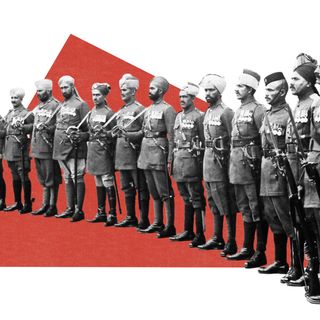
Why We Expect People With Invisible Disabilities To Learn To Act ‘Normal’
Unless someone’s disabilities are apparent, we expect them to learn how to act ‘normal’ — resulting in discrimination and fewer accessibility options.

As an individual on the autism spectrum, my senses are easily overwhelmed. This prevents me from being able to concentrate in brightly lit spaces or work efficiently in typical office settings — busy spaces with people chattering, typing into their laptops, eating (all food smells), or simply existing around me. Similarly, my auditory processing challenges as well as my inability to keep pace with neurotypical communication make group discussions and social interactions incredibly stressful and difficult for me. But because my challenges are invisible, no matter how debilitating they may be, they are easily dismissed by others. In fact, people have often asked me to simply “get over” my sensory challenges — as if I can just will them away.
When it comes to invisible disabilities like autism, people are expected to somehow learn the ropes of a so-called ‘normal’ lifestyle. So, despite autism being considered a disability in various parts of the world, including India, the needs of autistic individuals are rarely recognized within education systems and workplace cultures, both of which are still designed with neurotypical people in mind. This begs the question: is the reluctance to accommodate the needs of autistic individuals rooted in the fact that we don’t often appear different? Experts believe so.
The lack of any physiological marker is certainly a very big reason behind society refusing to accommodate people with hidden disabilities, says Merry Barua, founder and director of Action for Autism, a national NGO. “But there is more to it,” she adds. “Autism challenges people’s perception of disability itself.” People fail to understand that a conventionally intelligent individual can find communication challenging, or may struggle to function in the same environment as everyone else.
“Schools aren’t as reluctant to get visually challenged students software to facilitate their learning. They feel good about learning sign language to help students with hearing impairments. … But when it comes to autism, there is this strong unwillingness we face from schools to make accommodations — because if the children look typical, why shouldn’t they learn to behave typically?” Barua says.
Related on The Swaddle:
Pandemic Isolation Has Been a Relief for Many Who Don’t Fit into Society’s Norms
But this hidden nature of autism, and other invisible disabilities, has a very tangible cost. “Autistic kids are either not admitted, or routinely expelled from schools,” Barua says. She mentions a student whose school was trained to accommodate autistic children like him but refused to extend its support as soon as he graduated tenth grade — because, according to them, he should have learned to overcome his challenges by then. In order to explain that a person doesn’t simply outgrow their autism with age, Barua had to cite the example of a more visible, physical struggle. She asked the boy’s teacher: “Now that you’ve worn glasses for nine to 10 years, you probably don’t need them anymore, do you?”
Rishabh Birla, 25, had a similar experience at his former workplace. He disclosed his autism diagnosis to his employers before starting his job, explaining the support he would need from them due to his executive dysfunction, his sensory issues, and his neuroatypical communication patterns. Yet, his employers and co-workers simply couldn’t understand why a person who doesn’t appear different would need any form of long-term support like detailed, point-to-point instructions for tasks, written agendas prior to meetings, or simply, the liberty to excuse himself if sensory difficulties arose during work. While the company had agreed to help initially, “I think they felt I would be able to overcome my struggles after two to three months without realizing I’ll need support for the whole job,” he says, adding that their attitude impacted his ability to perform at his job. “I started hating my work and had feelings of anger and resentment because there was a lack of acceptance, support, and understanding in the workplace. I had many meltdowns and anxiety attacks while at work and during meetings,” he recalls.
Across countries and cultures, the experiences of people with invisible struggles mirror each other. “I’m constantly anxious that my ‘luck’ will run out. Either in being able to work at all, or that my workplace will run out of patience and I’ll be out of a job,” Rebecca Allen, 30, who lives in London and has hypermobility syndrome, told The Guardian. She believes that the lack of understanding around hidden disabilities — “whether it’s real or not, whether it could exist at all” — hurt people like her who are trying to earn a living for themselves in an aggressively ableist world.
But these experiences extend beyond careers and education, seeping into people’s personal relationships as well. For Rishabh, the lack of understanding has affected his friendships as well as his health. “[I’ve become] so anxious, depressed, and fearful of society that I’ve left doing things I like due to lack of acceptance and understanding… To fulfill their expectations of ‘normal,’ I have to mask myself to my breaking point,” he says. And for many autistic individuals like Rishabh, masking who they are for prolonged periods of time can lead to autistic burnout, suicidal tendencies, and even losing one’s sense of self.
While some organizations simply lack the will to be accommodating, well-intentioned people, too, can falter at adjusting their expectations of individuals living with invisible disabilities — simply because what they see in front of them does not match their existing perception of disabilities. “The international symbol for disabilities is a person in a wheelchair, so that’s how people have been conditioned to see disability,” explained Marni Walkerden, a disability rights activist, who lives with hereditary spastic paraplegia, another hidden disability.
Barua explains that “it is easy to make a physical accommodation for someone… but it’s a much harder task to change one’s own mindset and attitude.” And that’s where people often fail, since they refuse to acknowledge what they can’t see.
Related on The Swaddle:
Not only can the invisibility of one’s struggles prevent one from getting the support one needs, but it can also get in the way of acknowledgment by experts trained to diagnose their condition. For years, mental health professionals dismissed Rakshita Shekhar’s self-diagnosis of autism because she ‘looked too normal’ to be autistic. “One [doctor] said I couldn’t be autistic because I had recently had a baby, which was proof of a good sex life. Another one asked my husband if he wanted to leave me. When he said while I did have my struggles, he was happy with me — I was dismissed by the psychologist. Yet another one said I spoke so well that I couldn’t be autistic,” she recalls.
Rakshita, now 33, finally received her diagnosis last year. But the disbelief and rejection she faced from almost 10 trained professionals, one after the other, invalidated her lived experience and questioned her “symptoms and identity” — a series of events that have led many individuals on the spectrum to develop imposter syndrome. “I used to come back crying every time. I used to blame myself for not being able to communicate properly,” she says.
In addition, using labels like “high-functioning” — which are based on how the person appears, rather than how easy or difficult it is for them to navigate the world — further strengthens the resistance against accommodating invisible challenges.
Normalcy itself is being flipped on its head by the pandemic, and that has brought me and countless others who don’t fit into society’s definition of ‘normal’ a much-needed respite from fulfilling expectations that are quite unnatural to us. But until society is willing to stop judging books by their covers, and to believe and empathize with what the books are actually saying instead, very little can change in the long term. The first step towards a more inclusive world is understanding that invisible doesn’t mean non-existent.
Devrupa Rakshit is an Associate Editor at The Swaddle. She is a lawyer by education, a poet by accident, a painter by shaukh, and autistic by birth. You can find her on Instagram @devruparakshit.
Related


U.K. Apologizes for Racism That Kept India’s WWI Dead From Due Recognition
